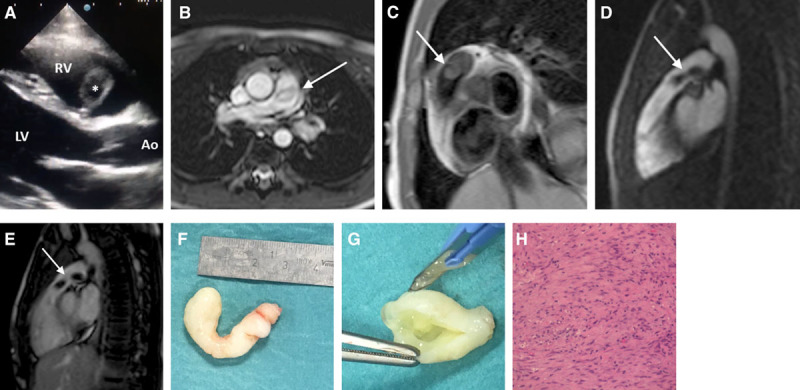A 9-year-old boy with previous history of microhematuria and intermittent fever was admitted to hospital for routine screening. At presentation, he complained about recurrent shortness of breath and lethargy. His past medical history was unremarkable for cardiac symptoms. Laboratory data revealed normal white blood cells count (6700/μL), erythrocyte sedimentation rate, and C-reactive protein. The results of blood and urine cultures were negative.
Physical examination and ECG did not reveal abnormalities. Transthoracic echocardiography showed a nonhomogeneous polypoid mass. It was arising from right ventricular outflow tract, projecting to pulmonary valve, and prolapsing to pulmonary artery during systole (Figure [A], Movie I in the Data Supplement).
Figure.

Cardiac inflammatory myofibroblastic tumor (IMT). Three chamber view in transthoracic echocardiography, (A) showing a polypoid mass (*) in right ventricular outflow tract. Cardiac magnetic resonance confirms the presence of a pedunculated tumor (arrow) prolapsing to main pulmonary trunk in end-systole (B). The mass is hyperintense in T2/T1-weighted cine-images (B), heterogeneously isointense in T1-weighted (C), and it does not show early or late gadolinium enhancement (D and E). Macroscopic (F and G) and histopathologic (H) appearance of cardiac IMT. Ao indicates aorta; LV, left ventricle; and RV, right ventricle.
Cardiac magnetic resonance confirmed the presence of a mobile and pedunculated tumor with maximum size of 38×12 mm. It was hyperintense in T2/T1-weighted cine-images (Figure [B], Movie II in the Data Supplement), hyperintense in T2-weighted sequences, heterogeneously isointense in T1-weighted (Figure [C]), and without significant restriction of water diffusivity on diffusion-weighted imaging (b300).
It did not show early enhancement at first-pass perfusion (Figure [D], Movie III in the Data Supplement), nor late gadolinium enhancement (Figure [E]). Ventricles were normal in size and function, with no evidence of myocardial late gadolinium enhancement. The provisional diagnosis of cardiac inflammatory myofibroblastic tumor (IMT) was made, which necessitated cardiac surgery. The child underwent tumor excision by means of median sternotomy and extracorporeal circulation. It revealed a mobile yellowish-white polypoid mass with a small pedicle attached to endocardium without signs of myocardial infiltration. The lesion was grossly firm, stringy, and partially beaded (Figure [F and G]).
Histopathologic examination revealed a mesenchymal tumor composed of scattered spindle myofibroblasts, infiltration of lymphocytes, and plasma cells and sparse fibrin deposits on tumor surface (Figure [H]). Cells were positive for vimentin and smooth muscle actin and negative for CD34, myoD1, pancytokeratin, and anaplastic lymphoma kinase-1. The histopathology was consistent with IMT.
After surgery, the patient recovered successfully with no evidence of tumor recurrence at 2-month follow-up echocardiography.
With <60 cases reported in scientific literature, cardiac IMTs represent a very rare entity, which usually present as endocardial-based cavitary masses.1 The majority of cardiac IMTs have occurred in children and young adults, with a predominance for the right-side of the heart.
The differential diagnosis includes myxoma, fibroelastoma, and low-grade sarcoma. MR imaging characteristics of cardiac IMT are not well described due to its rarity and depend on their cellular and myxoid composition.2 Cardiac magnetic resonance may substantially support the diagnosis, allowing for tissue characterization by evaluating the intrinsic (T1- T2- and diffusion-weighted imaging) and extrinsic tumor parameters (first-pass perfusion and late gadolinium enhancement imaging). In our case, heterogenous T2-hyperintensity and T1-isointensity of the cardiac mass were inconsistent with the diagnosis of thrombus. In addition, the absence of early or late gadolinium enhancement made the hypothesis of myxoma or low-grade sarcoma unlikely.
Histopathology is essential for the diagnosis of IMT and spindled myofibroblastic proliferation with chronic inflammatory infiltrate represent the pathognomonic histological pattern.
Etiopathogenesis of cardiac IMT is still uncertain, and despite some open controversies on its biologic nature, it is currently considered a benign low-grade neoplasm. However, because of its location within the heart, IMT may potentially be fatal due to high risk of embolic complications.3 Clinical symptoms and laboratory findings are aspecific, and the treatment should include surgery, despite a little potential for recurrences has been reported.
Supplementary Material
Footnotes
The Data Supplement is available at https://www.ahajournals.org/doi/suppl/10.1161/CIRCIMAGING.119.009443.
Disclosures
None.
References
- 1.Eilers AL, Nazarullah AN, Shipper ES, Jagirdar JS, Calhoon JH, Husain SA. Cardiac inflammatory myofibroblastic tumor: a comprehensive review of the literature. World J Pediatr Congenit Heart Surg. 2014;5:556–564. doi: 10.1177/2150135114546203 [DOI] [PubMed] [Google Scholar]
- 2.Tao TY, Yahyavi-Firouz-Abadi N, Singh GK, Bhalla S. Pediatric cardiac tumors: clinical and imaging features. Radiographics. 2014;34:1031–1046. doi: 10.1148/rg.344135163 [DOI] [PubMed] [Google Scholar]
- 3.Burke A, Li L, Kling E, Kutys R, Virmani R, Miettinen M. Cardiac inflammatory myofibroblastic tumor: a “benign” neoplasm that may result in syncope, myocardial infarction, and sudden death. Am J Surg Pathol. 2007;31:1115–1122. doi: 10.1097/PAS.0b013e31802d68ff [DOI] [PubMed] [Google Scholar]
Associated Data
This section collects any data citations, data availability statements, or supplementary materials included in this article.


